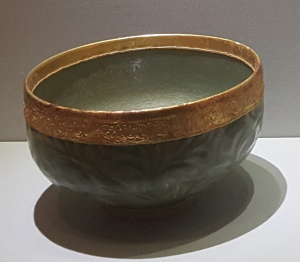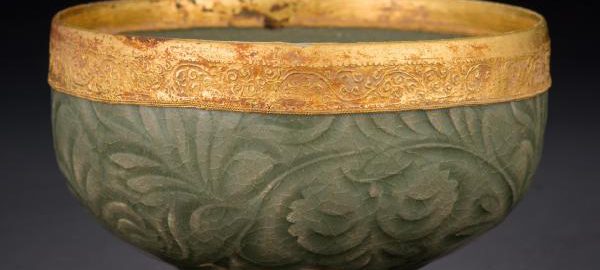

Bowl with Peonies
China, YaoZhou kilns
11th Century
Porcelain with Vietnamese gold rim
Celadon originated in China which later spread to other regions in China. Celadon wares were highly regarded by the Chinese imperial court as it is similar to the color of jade. As we can see how highly regarded celadon wares were in China, we can assume that they were considered highly valuable items during trading and only the wealthy might be able to afford it.
Decorations in chinese celadons is limited, normally by shaping the wares body or creating shallow designs (such as the peonies shown on the bowl) on flat surface, allowing the glaze to pool in depressions to give a much deeper colour to accentuate the design. There was rarely any celadon ware which contained a different colour. This is probably because celadon was regarded to be beautiful with the association of jade green. To add colour onto it might remove what celadon is known for: A greenware with a transparent glaze.
A gold rim was added to this celadon bowl in Champa, a culture which flourished in central and southern Vietnam from the 7th to the early 19th century. It shows how cross- cultural exchange was happening way back even in the 11th century. The Vietnamese who owned this porcelain have decided to add their own culture design was onto the bowl, recreating an object that consist of two different cultures. We can see the intricate designs on the gold rim, as if matching the peonies design on the bowl. They might have felt adding additional colours and designs onto the bowl will help beautify it event more, unlike how the chinese felt that celadon wares should be left jade green.
We can infer that the function of the item was to contain maybe soup or water as we know it is a bowl. We can also infer the kind of people who might have used the bowl. A mixture of gold and celadon suggests someone of somewhat of royalty or higher status could have owned it. It mostly likely wouldn’t be a common household object that can be readily found around Vietnam.
